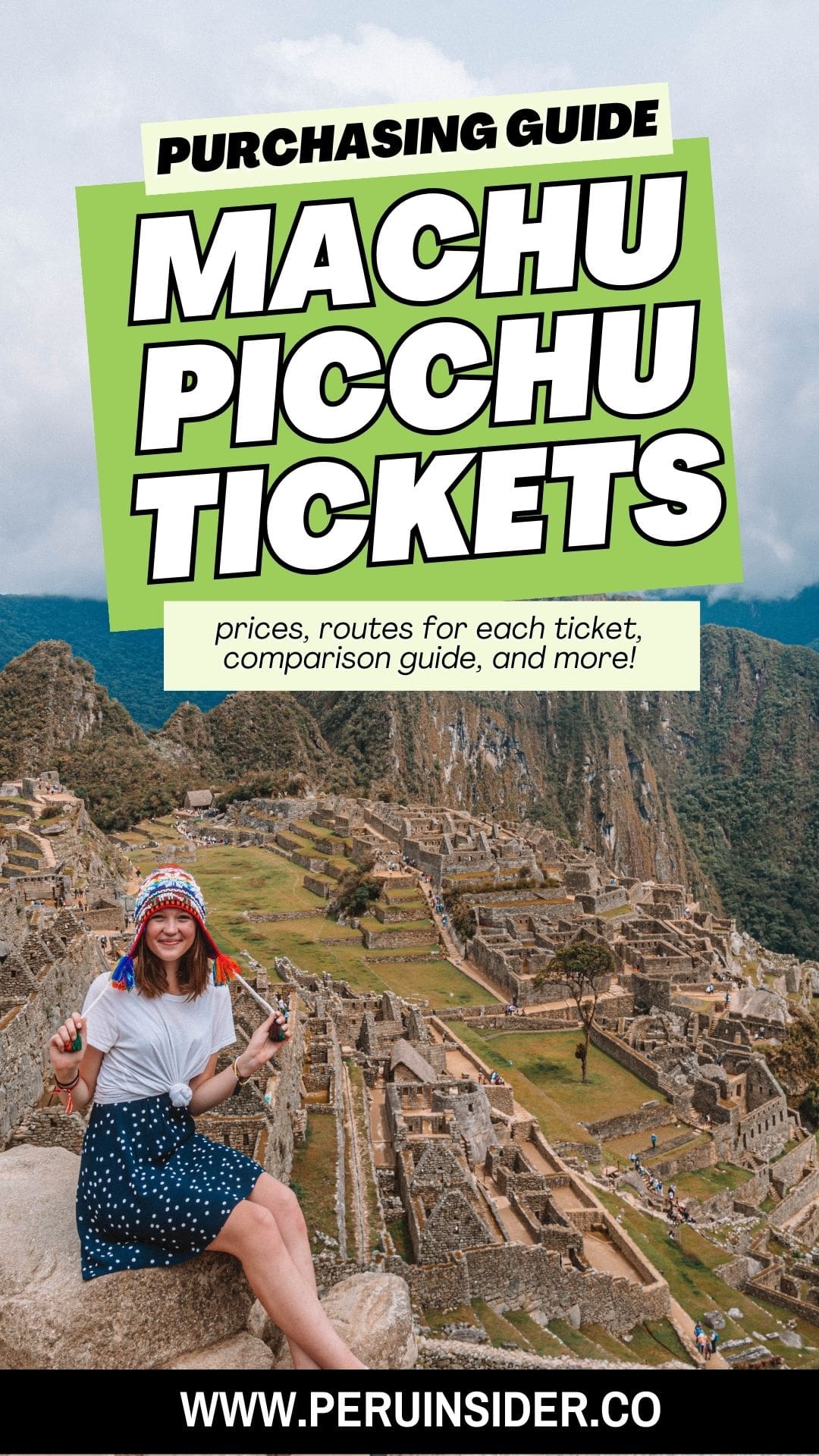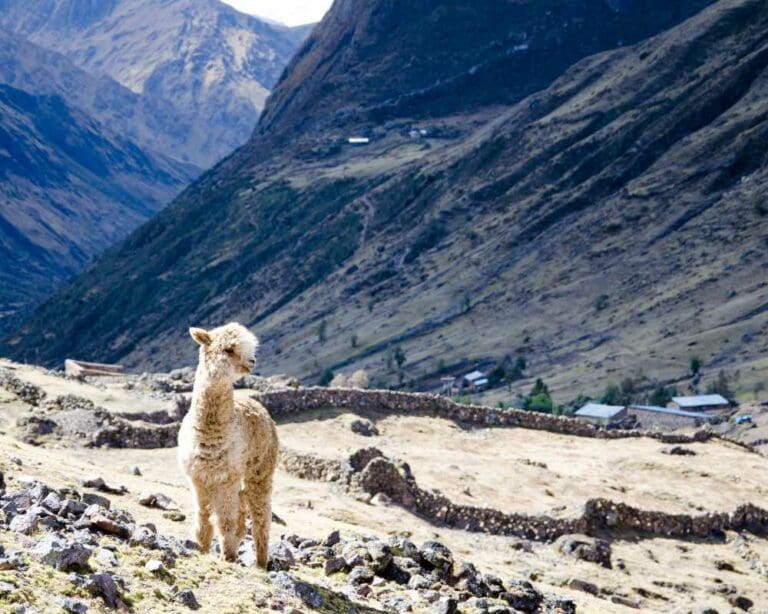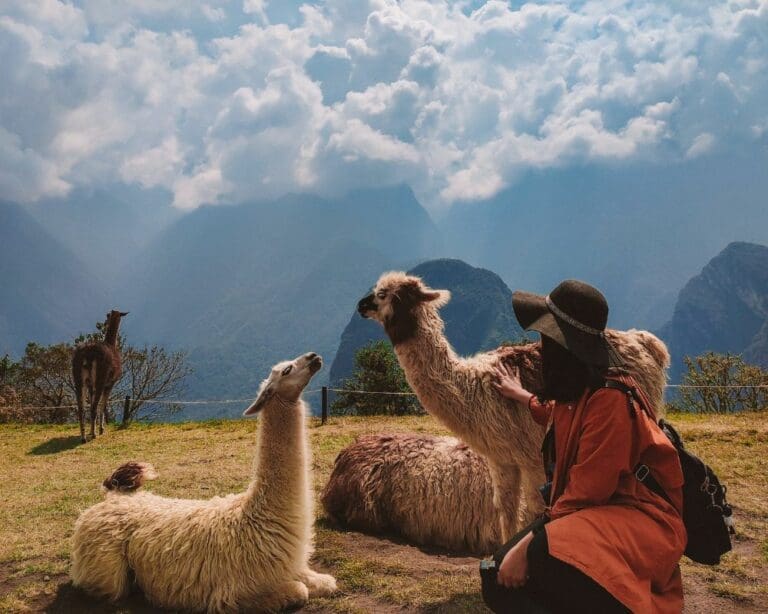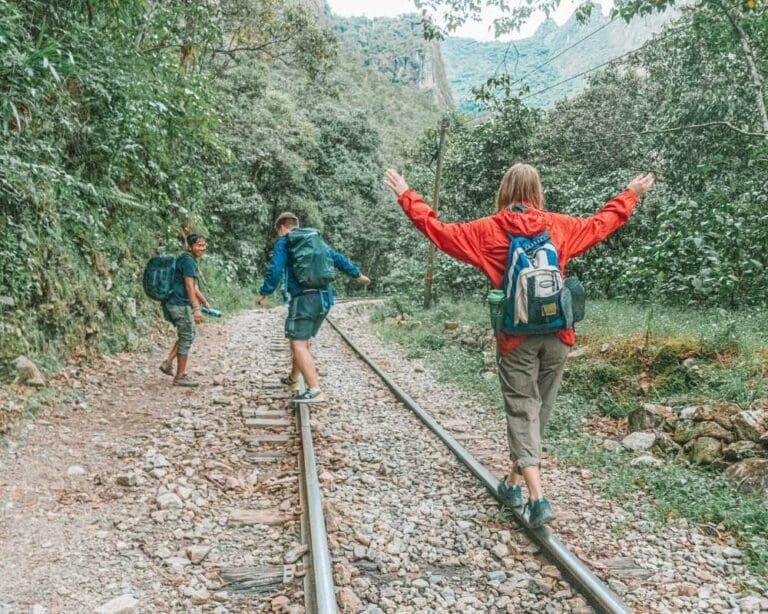Machu Picchu Tickets Purchasing Guide: which ticket is best for you?
Before you pack your bags, here’s a detailed purchasing guide for Machu Picchu tickets. Find out which one is best for you!
Embarking on a journey to the mystical heights of Machu Picchu is an adventure that tops many travelers’ bucket lists.
Nestled among the cloud-shrouded peaks of the Peruvian Andes, this ancient Incan citadel invites explorers to witness its majestic beauty and unravel its centuries-old mysteries.

However, before you lace up your hiking boots and set your sights on this UNESCO World Heritage Site, navigating the process of purchasing tickets is a crucial first step.
In this comprehensive guide, we’ll walk you through the various routes inside the Machu Picchu Citadel, detailing the prices of each route to help you plan your visit effectively.
🦙 Join our 14-day Peru expedition!

Discover Peru from Lima to Cusco on a 14-day expedition with the coolest travelers on the block! Our group trips to Peru are joined by a super fun and dynamic group of travelers of all ages!
Here’s a breakdown of the different types of Machu Picchu tickets and how to purchase them:
🎟️ Circuit 1 Machu Picchu tickets

Circuit 1 is less popular than Circuit 2 but is one of the 2 best Machu Picchu tickets to buy. This is where the best photo spots are and is less crowded than Circuit 2. You can complete Circuit 1 within 2 hours.
Highlights of this Machu Picchu ticket include the “Espejo de Agua” (Water Mirror). It is one of Machu Picchu’s remarkable architectural features, showcasing the Inca’s advanced understanding of hydraulics and their ability to integrate natural elements into their built environment.
It is essentially a water feature, designed to reflect the sky and surrounding landscape. These water mirrors were used not only for aesthetic purposes but also had practical applications, such as for agricultural experimentation, religious ceremonies, and as part of the sophisticated irrigation systems that supported the terrace farming prevalent in Inca society.
Another interesting route here is the “foso seco” which translates to “dry moat” in English. It is one of the distinctive architectural features of this ancient Inca site. Unlike traditional moats filled with water, a dry moat was used by the Incas as a defensive mechanism or as a part of their sophisticated drainage systems.
In Machu Picchu, the dry moat serves both to protect the site and to manage rainwater, helping to prevent erosion and landslides in this mountainous terrain. This feature highlights the Incas’ advanced engineering skills and their ability to adapt their construction techniques to the challenging Andean environment.
🚌 Recommended: How to get from Cusco to Machu Picchu in 6 ways
Circuit 1 Machu Picchu Tickets Inclusion
The following landmarks are included in the Circuit 1 Machu Picchu tickets:
🏆 Circuit 2: best Machu Picchu tickets to buy

Circuit 2 is the best Machu Picchu tickets to buy and has more routes than Circuit 1. Here, you will get access to the famous photo spots of Machu Picchu that you see on Instagram and social media. This route takes longer (about 3 hours).
One of the most unique features of Circut 2 Machu Picchy ticket is the Intiwatana Pyramid. It is home to one of the site’s most significant and well-preserved ritual stones, known as the Intiwatana stone.
This Quechua term translates to “hitching post of the sun,” which reflects the stone’s purpose as an astronomical clock or calendar used by the Incas to mark the solstices and equinoxes.
The Intiwatana stone is strategically positioned at the top of a pyramidal structure, allowing it to serve as a precise solar observatory that aligns with the sun’s position at key times of the year.
The Intiwatana stone is considered one of the most sacred objects at Machu Picchu, believed to hold the power to tie the sun to the earth, ensuring its return and thus, the continuity of life.
💰 You might also like: Machu Picchu trip cost breakdown
Circuit 2 Machu Picchu Tickets Inclusion
The following landmarks are included in the Circuit 2 Machu Picchu tickets:
🎫 Circuit 3 Machu Picchu tickets

Circuit 3 Machu Picchu tickets are just OK. Again, I prefer Circuits 1 & 2, especially for photos. Circuit 3 is best if you’re in a hurry and only have 1-1.5 hours.
In Circuit 3, the most interesting inclusion in the Machu Picchu tickets is the “Inka House,” also known as the “Casa del Inka” or “Inca’s House.”
It is believed to have been a residence of high status, possibly for an Inca ruler or high-ranking official visiting the site. This structure is characterized by its superior construction quality, including finely worked stones that fit together tightly without mortar, typical of important Incan buildings.
Located near the central area of Machu Picchu, close to key religious and ceremonial sites, the Inka House’s placement suggests its significance within the complex. It may have served multiple functions, including administrative duties, ceremonial activities, or as a dwelling for nobility.
The building’s features, such as trapezoidal windows and doors, a common architectural element in Incan construction that enhances earthquake resistance, reflect the sophisticated engineering and architectural skills of the Inca civilization.
The Inka House is part of the larger Machu Picchu site, which was built in the 15th century and is a masterpiece of architecture and engineering. Its well-preserved state offers insights into the daily lives of its inhabitants and the overall organization of Incan society.
Circuit 3 Machu Picchu Tickets Inclusion
The following landmarks are included in the Circuit 3 Machu Picchu tickets:
⛰️ Circuit 4 Machu Picchu tickets

Circuit 4 is quite similar to Circuit 2 Machu Picchu tickets but without the main and secondary platforms. This route takes about 2.5 hours. What’s unique here is the “Qolqas Orientales” which are the Eastern Storehouses.
They are part of a group of structures believed to have been used by the Incas for storage purposes. These storehouses, or qolqas, are strategically positioned on the eastern side of the Machu Picchu archaeological site, utilizing the natural ventilation and cooler temperatures provided by their elevated location to preserve food and other goods.
Constructed with the characteristic precision and care of Incan architecture, these storehouses exemplify the Incas’ advanced understanding of environmental factors and their impact on the preservation of perishable goods.
🥾 Recommended: What to pack for Machu Picchu
Circuit 4 Machu Picchu Tickets Inclusion
The following landmarks are included in the Circuit 4 Machu Picchu tickets:
Circuit 4 is suggested to those who are planning to hike Huayna Picchu or Huchuy Picchu. You can’t purchase this circuit on its own.
🚵♂️ Circuit 5: for Inca Trail Hikers only

Inca Trail hikers enter Machu Picchu through the “Inti Punku,” also known as the Sun Gate. This entrance offers a breathtaking first view of the ancient city from above, providing a memorable and dramatic introduction to the site.
Inti Punku is situated at a higher elevation on the mountainside and was strategically placed to align with the sun during certain astronomical events, such as the summer solstice.
It served as a controlled entry point to Machu Picchu in Incan times and continues to be the culmination of the 4-day Inca Trail trek, allowing hikers to experience the site similarly to how Incan pilgrims might have approached the city centuries ago.
The arrival at Inti Punku is often considered one of the most rewarding moments of the hike, marking the end of a challenging journey with a stunning panoramic view of Machu Picchu and its surrounding landscape.
A unique stop here that aren’t included in other Machu Picchu tickets is the “Tres Portadas” (“Three Doorways” or “Three Portals).
This is a section of Machu Picchu where three trapezoidal doorways are built side by side, each leading into a separate room. This architectural element is part of a larger complex known as the Royal Sector or the Principal Sector, which is believed to have housed the nobility or served as ceremonial spaces.
🚫 You might also like: Is it safe to travel to Machu Picchu?
Circuit 5 Machu Picchu Tickets Inclusion
The following landmarks are included in the Circuit 5 Machu Picchu tickets:
🦙 Machu Picchu Tickets Comparison (Circuits 1-5)
Below is the summary for the 5 different Machu Picchu tickets (entrance fee only).
| C1 | C2 | C3 | C4 | C5 | |
|---|---|---|---|---|---|
| Secondary Platform | ✅ | ✅ | ❌ | ❌ | ❌ |
| Main Platform | ✅ | ✅ | ❌ | ❌ | ❌ |
| Foso Seco | ✅ | ✅ | ✅ | ✅ | ✅ |
| Temple of the Sun Viewpoint | ✅ | ✅ | ✅ | ✅ | ✅ |
| Caos Granitico | ✅ | ✅ | ✅ | ❌ | ❌ |
| Espejos de Agua | ✅ | ✅ | ❌ | ✅ | ❌ |
| Plaza De Los Templos | ❌ | ✅ | ❌ | ❌ | ❌ |
| Intiwatana Pyramid | ❌ | ✅ | ❌ | ❌ | ❌ |
| Sacred Rock | ❌ | ✅ | ❌ | ✅ | ❌ |
| Doce Vanos | ❌ | ✅ | ❌ | ✅ | ✅ |
| Qolcas Orientales | ❌ | ✅ | ❌ | ✅ | ❌ |
| Condor Temple | ❌ | ✅ | ❌ | ✅ | ❌ |
| Qolqas | ❌ | ❌ | ✅ | ✅ | ✅ |
| Zona Agricola | ❌ | ❌ | ✅ | ✅ | ✅ |
| Canal de Agua | ❌ | ❌ | ✅ | ✅ | ✅ |
| The Inka House | ❌ | ❌ | ✅ | ✅ | ❌ |
| Water Bridges | ❌ | ❌ | ✅ | ✅ | ✅ |
| Tres Portadas | ❌ | ❌ | ❌ | ❌ | ✅ |
| Pisonay Plaza | ✅ | ✅ | ✅ | ✅ | ✅ |
| Archaeological Reserve | ✅ | ✅ | ✅ | ✅ | ✅ |
If you want to see the descriptions for each site in the Machu Picchu citadel, you can go to our post, the best things to do in Machu Picchu.
🧭 Circuit 4 + Huayna Picchu tickets

Purchasing Machu Picchu tickets with an added visit to Huayna Picchu (Wayna Picchu) offers several unique benefits, making it a highly recommended option for travelers seeking a more in-depth experience of this ancient site:
Huayna Picchu has limited entry, with only a certain number of visitors allowed each day in specified time slots. This limited access ensures a more exclusive and less crowded experience.
Along the way to the top of Huayna Picchu, you’ll encounter additional Incan ruins that are not accessible with a standard Machu Picchu ticket. This includes the Temple of the Moon and other ceremonial sites, which provide a deeper insight into the Incan civilization and their architectural ingenuity.
⛰️ Recommended: The ultimate guide to the Choquequirao Trek to Machu Picchu
Is it worth climbing Huayna Picchu?

ABSOLUTELY! The hike up Huayna Picchu provides some of the most stunning views of Machu Picchu and the surrounding Andean landscape. From the summit, you can look down upon the Inca citadel from a unique vantage point, offering perspectives that can’t be seen from the main site itself.
The Huayna Picchu hike is considered to be of moderate to challenging difficulty, depending on one’s physical condition and experience with hiking, especially on steep and narrow paths.
Some parts of the trail are narrow and can be challenging to navigate, especially when passing other hikers. The path also includes sections that are carved directly into the rock, with precipitous drops on one side, which requires careful footing.
How steep is Huayna Picchu?

Huayna Picchu is known for its steepness, which is a significant part of the challenge and allure for hikers. The mountain rises about 360 meters (nearly 1,180 feet) above the main part of the Machu Picchu site. The paths leading to the summit are steep and, in some sections, almost vertical, with narrow staircases and trails carved directly into the rock.
The incline varies throughout the hike, with some of the steepest parts involving narrow steps known as the “stairs of death” due to their steepness and exposure.
These stairs can have inclines of 60 degrees or more, which is particularly daunting for those with a fear of heights. Despite the challenging ascent, safety measures such as handrails and cables in the steepest parts help hikers navigate the climb.
What is the altitude in Huayna Picchu?

Huayna Picchu stands at about 2,720 meters (8,920 feet) above sea level, and the altitude can affect hikers not acclimated to high elevations. Symptoms of altitude sickness include shortness of breath, fatigue, and dizziness, which can make the hike more challenging.
How long does it take to hike up Huayna Picchu?

The hike to the summit of Huayna Picchu and back can take between 1.5 to 3 hours, depending on one’s pace. The round trip is approximately 4 kilometers (2.5 miles), but the steep and uneven terrain makes it more demanding than a similar distance on flat ground.
Weather can also impact the difficulty of the hike. Rain can make the trail slippery, while hot weather can lead to quicker dehydration and increased fatigue.
🗺️ Circuit 4 + Huchuy Picchu

Purchasing Machu Picchu tickets with access to Huchuy Picchu offers a unique opportunity to enhance your visit to this iconic site with several compelling benefits:
Huchuy Picchu, being a less well-known option compared to Huayna Picchu or Machu Picchu Mountain, tends to attract fewer visitors.
This means you can enjoy a more peaceful hike and have the chance to appreciate the stunning views and ancient ruins without the crowds.
💡 You might also like: 30 Machu Picchu facts
Is Huchuy Picchu worth it?

Yes! Especially the trek to Huchuy Picchu is significantly easier and shorter than the one to Huayna Picchu or Machu Picchu Mountain.
This makes it an ideal choice for visitors who want the experience of hiking within the archaeological site but may not be prepared for the more strenuous climbs. It’s accessible for a wider range of fitness levels, including families with children.
Although not as high as Huayna Picchu or Machu Picchu Mountain, Huchuy Picchu still offers beautiful views of the Machu Picchu citadel and surrounding mountains.
Its unique vantage point allows for different photographic opportunities and perspectives of the Inca ruins and the natural beauty of the area.
Is Huchuy Picchu the same as Huayna Picchu?

No, Huchuy Picchu is not the same as Huayna Picchu. While both are located within the Machu Picchu archaeological complex, they are distinct mountains offering different experiences.
Huayna Picchu is the more famous of the two, known for its steep pathways and dramatic views of the Machu Picchu ruins. Huchuy Picchu, on the other hand, is a smaller mountain located closer to the Machu Picchu citadel, offering a shorter and less strenuous hike.
How high is Huchuy Picchu?

Huchuy Picchu stands at an elevation of approximately 2,720 meters (8,924 feet) above sea level.
It is lower than Huayna Picchu and Machu Picchu Mountain, making it a more accessible option for many visitors looking to experience a hike with panoramic views without the more challenging ascent.
How long does it take to climb Huchuy Picchu?

Climbing Huchuy Picchu typically takes about 1 to 2 hours round trip, making it a relatively short hike compared to other routes in the Machu Picchu area.
This duration makes it an appealing option for those who want to add a hiking experience to their visit without allocating the time required for the longer treks to Huayna Picchu or Machu Picchu Mountain.
🚍 Recommended: How to get to Machu Picchu in 17 ways
Is Huchuy Picchu a difficult hike?

Huchuy Picchu is considered an easy to moderate hike. It is less strenuous and has a lower elevation gain compared to the hikes to Huayna Picchu or Machu Picchu Mountain.
The path is well-marked and less challenging, making it suitable for visitors who are looking for a manageable hike that still offers the reward of stunning views of the Machu Picchu citadel and its surroundings.
This accessibility makes Huchuy Picchu a good option for families, less experienced hikers, or those limited by time.
Purchasing a ticket that includes access to Huchuy Picchu is an excellent way to experience the magic of Machu Picchu with added ease and a unique perspective.
It’s especially suitable for those looking for a less strenuous hike without missing out on the breathtaking beauty and historical richness of this UNESCO World Heritage site.
🚞 Circuit 3 + Machu Picchu Mountain
Purchasing Machu Picchu tickets with access to Machu Picchu Mountain (Montaña Machu Picchu) offers a unique set of advantages for visitors looking to enhance their experience of this iconic site:
Is it worth climbing Machu Picchu Mountain?

ABSOLUTELY! While still popular, Machu Picchu Mountain tends to be less crowded than the hike to Huayna Picchu, offering a more serene and less rushed experience.
This can be particularly appealing for those who prefer a more contemplative visit or wish to avoid the larger crowds.
Machu Picchu Mountain provides some of the most stunning panoramic views available of the entire archaeological site and the surrounding Andean landscape, including the Urubamba River.
The higher elevation offers a different perspective compared to other parts of the site, allowing for breathtaking photography and a deeper appreciation of the area’s natural beauty.
✈️ Related: How to get to Machu Picchu from Lima in 6 steps
How hard is it to climb Machu Picchu Mountain?

The hike to Machu Picchu Mountain has moderate difficulty. The summit of Machu Picchu Mountain is about 3,082 meters (10,111 feet) above sea level, and the climb starts from Machu Picchu itself, which is at about 2,430 meters (7,970 feet).
This means hikers will ascend approximately 652 meters (2,139 feet) throughout the hike. The trail to the summit is roughly 2 to 2.5 miles (3.2 to 4 km) one way, making the round trip about 4 to 5 miles (6.4 to 8 km).
Parts of the trail are steep and can be physically taxing, especially for those not used to hiking in mountainous terrain.
The high altitude can make the hike more challenging for those not acclimatized. The thinner air at higher elevations means less oxygen is available, which can lead to symptoms of altitude sickness, such as shortness of breath, headache, and fatigue.
The hike to the summit and back can take between 3 to 4 hours, depending on your pace and how often you stop to rest or take in the views.
Despite these challenges, many find the hike to Machu Picchu Mountain rewarding due to the spectacular panoramic views of Machu Picchu, Huayna Picchu, the surrounding mountains, and the Urubamba River far below.
Securing Machu Picchu tickets with access to Machu Picchu Mountain is particularly important during the high season, as entry is limited to protect the trail and ensure a quality experience for visitors.
Circuit 1 or 2 with Inka Bridge
Purchasing Machu Picchu tickets with access to the Inka Bridge (Puente Inka) offers a unique addition to the exploration of this iconic site, enriching your visit with historical insights and breathtaking views.
Is the Inca Bridge worth it?

For sure! The Inka Bridge is an example of Incan engineering prowess. It served as a strategic military entrance and a control point for access to Machu Picchu.
While the main areas of Machu Picchu receive most of the visitors, the path to the Inka Bridge offers a more secluded and tranquil experience. This lesser-known aspect of the site allows for a moment of solitude amidst the natural beauty and historical majesty of the Andes.
The path to the Inka Bridge provides unique views of Machu Picchu and the surrounding canyon, offering a different perspective from the classic viewpoints. The dramatic setting highlights the Inca’s ability to integrate their architecture seamlessly with the natural landscape.
How do you get to the Inca Bridge in Machu Picchu?

To get to the Inca Bridge at Machu Picchu, you start from the main archaeological site itself. The route to the Inca Bridge is relatively straightforward and less strenuous compared to other hikes within the complex.
After entering Machu Picchu, follow the signs pointing towards the Inca Bridge. The trail branches off from the main path and leads westward along the mountain’s edge. It’s a short walk, approximately 20 to 30 minutes from the main site, depending on your pace.
Can you cross the Inca Bridge?

No, visitors cannot cross the Inca Bridge. For safety reasons, crossing the bridge is prohibited. The bridge is an ancient structure, consisting of a narrow path cut into the cliff face with a gap that was bridged by wooden planks.
The planks could be removed to protect the city from invaders. Today, to preserve the integrity of the site and ensure the safety of visitors, a barrier prevents people from walking across the actual bridge.
However, you can get close enough to appreciate the engineering ingenuity of the Incas and enjoy the views of the steep drop-off and surrounding mountains.
How long is the Inca Bridge?

The Inca Bridge itself is quite short, with the gap in the trail that the bridge spans being only a few meters wide. The exact length can vary slightly depending on the source, but it’s generally agreed to be around 4 to 6 meters (about 13 to 20 feet) across.
The bridge’s length is NOT its most notable feature; rather, it’s the strategic placement and the clever engineering solution it provided for controlling access to the city that make it remarkable.
Looking for more Machu Picchu travel guides?

![15 amazing Machu Picchu hotels in Aguas Calientes, Peru [with prices and review]](https://b3076322.smushcdn.com/3076322/wp-content/uploads/Machu-Picchu-Hotels-in-Aguas-Calientes-Peru-768x614.jpg?lossy=2&strip=1&webp=1)

![38 most beautiful places in the Andes Mountains Peru [with map!]](https://b3076322.smushcdn.com/3076322/wp-content/uploads/Andes-Mountains-Peru-Destinations-768x614.jpg?lossy=2&strip=1&webp=1)


![The 24 Peru Regions, explained [with free map!]](https://b3076322.smushcdn.com/3076322/wp-content/uploads/Peru-Regions-Map-768x614.jpg?lossy=2&strip=1&webp=1)